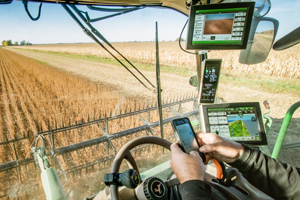HARNESSING DIGITAL CONNECTIVITY AND 5G TO SUPPORT CLEAN TECH
Digital connectivity has revolutionized the way we communicate, work, and interact with the world. Technology advancements such as 5G are emerging as powerful tools and proving critical in enabling smart infrastructure for a cleaner future.
 Technology advancements are proving critical in enabling smart infrastructure for a cleaner future. Among these innovations, digital connectivity and the fifth-generation wireless technology known as 5G are powerful tools that can optimize energy efficiency, transform industries, and enable novel solutions yet to be discovered.
Technology advancements are proving critical in enabling smart infrastructure for a cleaner future. Among these innovations, digital connectivity and the fifth-generation wireless technology known as 5G are powerful tools that can optimize energy efficiency, transform industries, and enable novel solutions yet to be discovered.
The global 5G infrastructure market is estimated to be US$14.29 billion in 2023 and is expected to reach US$125.31 billion by 2028, growing at a compound annual growth rate of 54.37%[1]. According to a 2022 report by Accenture, 5G is expected to reduce carbon dioxide emissions by 330.8 million metric tons by 2025[2].
5G offers significantly faster speeds, lower latency, and higher data capacity compared to previous generations, which means more devices can communicate with each other simultaneously with minimal delay. Additionally, 5G utilizes frequency that limits its range requiring towers to be spaced closer together. These new 5G towers, however, require lower power and are generally smaller and less conspicuous than their predecessor towers.
In fact, some are experimenting with utilizing existing infrastructure for 5G. In the paper “Analysis of Novel 5G Wireless Communication Coverage Enhancing Service Mode with Power Towers and Street Lamp Poles Integrated[3],” published in the 2022 IEEE Information Technology and Mechatronics Engineering Conference, the authors discuss placing 5G base stations on existing infrastructure such as power towers and street lamp posts.
 Source: https://www.digi.com/blog/post/5g-network-architecture
Source: https://www.digi.com/blog/post/5g-network-architecture
A promising 5G application is energy consumption optimization. 5G-enabled smart devices and sensors allow for real-time monitoring and control of energy-intensive processes. In the article”5G Multi-RAT URLCC and eMBB Dynamic Task Offloading with MEC Resource Allocation Using Distributed Deep Reinforcement Learning[4],” published in the IEEE Internet of Things Journal, the authors propose a deep reinforcement learning control scheme to satisfy the strict quality-of-service requirements of ultra-reliability low-latency communication (uRLLC) and enhanced mobile broadband (eMBB) using 5G multiple radio access technology (RAT)-based partial offloading and multi-access edge-computing (MEC) resource allocation. These results show an improved energy consumption performance over traditional schemes.
IEEE Senior member Dr. Babak Beheshti, Dean of the College of Engineering and Computing Sciences at the New York Institute of Technology, has made a career studying wireless and embedded systems and signal processing, and he agrees. He reflects on industries such as agriculture where connectivity has a positive impact. Smart sensors help farmers optimize water and fertilizer use for optimal soil conditions. “By introducing machine learning and AI algorithms in the sensor data, optimal watering and fertilization schedules can be deployed that would dynamically adapt to weather conditions,” he says. It is an example of how sensors digitally connected on a 5G network can together enable smart farming.
In the IEEE Industry Connections report “5G Enabled Agriculture Ecosystem: Food Supply Chain, Rural Development, and Climate Resiliency,” the authors describe an end-to-end agriculture ecosystem in the context of the food supply chain, rural development, and climate resiliency.
The data-sharing capabilities of 5G can support the development of efficient transportation systems that encourage the use of public transit over individual car ownership, while autonomous vehicles, relying on ultra-responsive connected systems, can improve traffic flow, enhance fuel efficiency, and significantly decrease accidents.
Renewable energy may also reap rewards from 5G innovation. Energy grids equipped with 5G-enabled sensors and smart meters can efficiently manage the fluctuating output of renewable sources such as solar and wind power. This dynamic management helps ensure that energy is distributed optimally.
While 5G delivers great advancements, there are challenges to overcome. One challenge is the cost of deployment of the technology. Dr. Beheshti says that “policymakers play a critical role in the deployment of these new technologies. Governments must create policies that facilitate spectrum allocation, infrastructure build-up, and communications networks to enable green tech to thrive.”
The modern digitally connected world, based on 5G and other technology, advances how things work and how we experience the world. “5G-enabled solutions can be combined with technologies such as AI, machine learning, cloud computing, nanotechnology, computer vision, and big data to create and deploy solutions that can help tackle the pressing problems we face,” says Dr. Beheshti.
Looking ahead, Dr. Beheshti says, “As with all generations of mobile communications standards, 5G is not the end of the road. 6G, the next generation of these standards, is expected to be commercially available by 2030. 6G will incorporate new communications technologies, including terahertz spectrum, AI and deep learning, and cognitive data networks in order to achieve a more comprehensive radio network that will be orders of magnitude faster than 5G.”
He continues, “IEEE’s fields of interest include many disciplines that naturally lend themselves to building careers focused on addressing the global impacts from climate change. While pursuing undergraduate degrees, students can take on internship positions in organizations that are focused on clean tech research that not only give them practical experience but also familiarize themselves with what topics align most with their own passions and aspirations. Throughout this journey, IEEE will be with these young professionals to provide them technical content, relevant standards, and educational content that are vetted by the most respected experts in the field.”
Digital Connectivity and 5G Are Critical Enabling TechnologiesIEEE Young Professional Climate Change and Sustainability Task Force member Cybele Ghanem, a computer and telecommunications engineer, talks about how digital connectivity is an enabling technology to mitigate climate change. |
[1] ltd, R. and M. (n.d.). Global 5G Infrastructure Market (2023-2028) by Communication Infrastructure, Network Technology, Operational Frequency, Network Architecture, End-User, and Geography, Competitive Analysis, Impact of Covid-19 with Ansoff Analysis. www.researchandmarkets.com. Available at: https://www.researchandmarkets.com/reports/5696683/global-5g-infrastructure-market-2023-2028-by?gclid=Cj0KCQjw0bunBhD9ARIsAAZl0E3C3_pDQqCcaScbJXJUpHwXFv3Ha5AbnAS-X9JUWmKJ4vR85lrGGXYaAlCPEALw_wcB
[2] newsroom.accenture.com. (n.d.). 5G-Enabled Technologies Could Solve for One-Fifth of U.S. Climate Change Target by 2025, New Study Finds. Available at: https://newsroom.accenture.com/news/5g-enabled-technologies-could-solve-for-one-fifth-of-us-climate-change-target-by-2025-new-study-finds.htm.
[3] J. Wang, Z. Jiao, Q. Wang, Y. Zhu and K. Li, “Analysis of Novel 5G Wireless Communication Coverage Enhancing Service Mode with Power Towers and Street Lamp Poles Integrated,” 2022 IEEE 6th Information Technology and Mechatronics Engineering Conference (ITOEC), Chongqing, China, 2022, pp. 1215-1220, doi: 10.1109/ITOEC53115.2022.9734701.
[4] J. Yun, Y. Goh, W. Yoo and J-M. Chung, “5G Multi-RAT URLLC and eMBB Dynamic Task Offloading With MEC Resource Allocation Using Distributed Deep Reinforcement Learning,” in IEEE Internet of Things Journal, vol. 9, no. 20, pp. 20733-20749, 15 Oct.15, 2022, doi: 10.1109/JIOT.2022.3177425.


